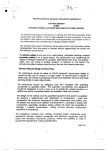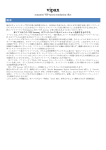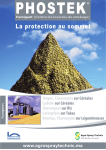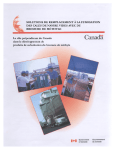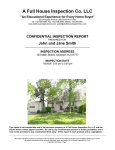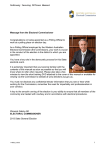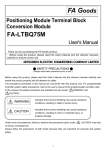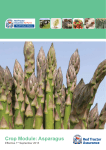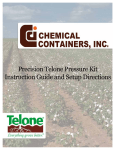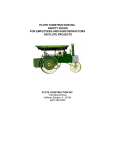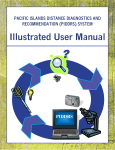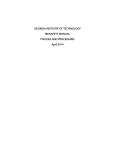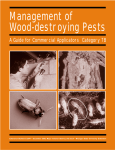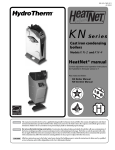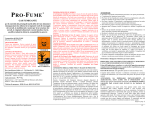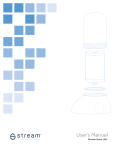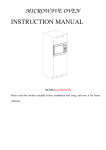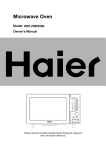Download Fumigation Study Guide for Hawaii
Transcript
PESTICIDE SAFETY EDUCATION PROGRAM Fumigation Study Guide for Hawaii March 2009 FOR PERSONS SEEKING CERTIFICATION BY THE STATE OF HAWAII DEPARTMENT OF AGRICULTURE TO BUY, USE, OR SUPERVISE THE USE OF RESTRICTED USE PESTICIDES FOR FUMIGATION This booklet is the March 2009 version. It replaces the January 2009 version. This version has two additions on page 20: Subsection “Fumigation Management Plan for Phosphine Fumigants” summarizes the requirement for a fumigation management plan (FMP) for applications of phosphine fumigant products and the major features of FMPs. Subsection “Fumigation Management Plan for Soil Fumigants” alerts soil fumigators to new requirements expected to appear on soil fumigant labeling in 2010. *** DEVELOPMENT OF THIS GUIDE WAS SUPPORTED IN PART BY THE STATE OF HAWAII DEPARTMENT OF AGRICULTURE. March 2009 Acknowledgement Disclaimer This study guide is based on the Utah Department of Agriculture’s Study Guide for Fumigation, which was downloaded in January 2007 from this web page: Where trade names are used, no endorsement is intended nor is criticism implied of similar suitable products not named. <www.ag.state.ut.us/plantind/ pest_app.html#study> and on the electronic version of E.J. Bond’s “Manual of fumigation for insect control” (1984, #54 in the series FAO Plant Production and Protection Papers) posted at: <http://www.fao.org/docrep/x5042e/ x5042E00.htm#Contents> We gratefully acknowledge the efforts of all authors, editors, and publishers. This study guide was developed for the Pesticide Risk Reduction Education program, a Cooperative Extension Service program of the College of Tropical Agriculture and Human Resources, University of Hawaii at Manoa. Please direct any question or comment about this guide to: Charles Nagamine Department of Plant and Environmental Protection Sciences 3190 Maile Way Room 307 Honolulu, HI 96822 Telephone: (808) 956-6007 Email: cynagami.hawaii.edu 2 Fumigation Study Guide for Hawaii Table of Contents Purpose of This Study Guide ...................................................................................4 Other Study Material .................................................................................................4 Labeling and Labels ..................................................................................................5 Pesticide Inspections .................................................................................................6 Introduction to Fumigation ......................................................................................6 How Fumigants Work ...............................................................................................7 How to Choose a Fumigant .......................................................................................8 Chemical and Physical Characteristics of Fumigants ...............................................9 Type and Nature of Fumigants ................................................................................11 Determining Need for Fumigation ..........................................................................14 Target Pest Considerations ......................................................................................14 Site Suitability Considerations ................................................................................15 Factors Affecting Fumigant Performance ...............................................................17 Safety Precautions and Protective Devices .............................................................20 Calculating Use Rates .............................................................................................25 Sealing .....................................................................................................................26 Applying the Fumigant ...........................................................................................28 Posting and Securing a Fumigation Site .................................................................29 Aerating ...................................................................................................................30 Special Considerations for Fumigant and Container and Disposal.........................31 Use Common Sense ................................................................................................33 Appendix: Specimen Labeling ................................................................................34 *** March 2009 3 Purpose of This Study Guide This study guide was developed for persons preparing for any of these State of Hawaii restricted use pesticide certification examinations: • Private 2 category (agricultural pest control with fumigants), for private applicators using or supervising the use of restricted use pesticides for soil fumigation in the production of an agricultural commodity and the application of restricted use pesticides for fumigation of agricultural products. • Commercial 7a category (fumigation pest control), for persons using or supervising the use of fumigant restricted use pesticides to control termites and other pests in or around food handling establishments, human dwellings, institutions such as schools and hospitals, industrial sites such as warehouses, grain elevators, and any other structures and adjacent area, public or private, and for the protection of stored, processed or manufactured products. • Commercial 7e category (vault fumigation pest control), for persons using or supervising the use of restricted use pesticides and fumigants in vaults or chambers to control pests in agricultural commodities or structural materials, and including stored, processed or manufactured products. • Commercial 9 category (regulatory pest control), for state, federal, or other government employees using or supervising the use of restricted use pesticides in the control of regulated pests prescribed under chapter 150A, Hawaii Revised Statutes, and the Federal Plant Pest Act. *** 4 Other Study Material A Complete Study Packet This study guide is just one item in a complete set of study items. A list of all the items in a complete set may be viewed at this webpage: <http://pestworld.stjohn.hawaii.edu/ studypackets/spcatgor.html> Specimen Labeling In following paragraphs, find the certification category that applies to you and read the note about specimen labeling. Private 2 category (agricultural pest control with fumigants)—If you are preparing for the certification examination for the Private 2 category (agricultural pest control with fumigants), review specimen labeling for the following fumigant products: ® • Fumitoxin Pellets (containing aluminum phosphide) ® • Degesch Fumi-Cels (containing magnesium phosphide) ® • Telone C-15 (containing 1,3-dichloropropene and chloropicrin) To learn how to get the “specimen labeling” for these products, read the last two pages of this study guide, “Appendix: Specimen Labeling.” Commercial 7a category (fumigation pest control)—If you are preparing for the certification examination for the Commercial 7a category (fumigation pest control), review specimen labeling for the following fumigant products: ® • Vikane (containing sulfuryl fluoride). In addition to the label, review the booklet titled Structural Fumigation Manual. (It explains how to use the fumigant efficiently and safely.) Fumigation Study Guide for Hawaii Chloropicrin Warning Agent (containing chloropicrin) To learn how to get the “specimen labeling” for these products, read the last two pages of this study guide, “Appendix: Specimen Labeling.” Labeling and Labels Commercial 7e category (vault fumigation pest control)—If you are preparing for the certification examination for the Commercial 7e category (vault fumigation pest control), review specimen labeling for the following fumigant products: ® • Fumitoxin Pellets (containing aluminum phosphide) ® • Degesch Fumi-Cels (containing magnesium phosphide) ® • ProFume (containing sulfuryl fluoride). In addition to the label, review the booklet titled Container Label and Applicator Manual for ProFume® gas fumigant. (It explains how to use the fumigant efficiently and safely.) To learn how to get the “specimen labeling” for these products, read the last two pages of this study guide, “Appendix: Specimen Labeling.” A label is the words and pictures placed on or packaged with the pesticide container by the manufacturer. A booklet or tag accompanying the container is part of the label. • Commercial 9 category (regulatory pest control)—If you are preparing for the certification examination for the Commercial 9 category (regulatory pest control), review specimen labeling for the following fumigant product: ® • ProFume (containing sulfuryl fluoride). In addition to the label, review the booklet titled Container Label and Applicator Manual for ProFume® gas fumigant. (It explains how to use the fumigant efficiently and safely.) To learn how to get the “specimen labeling” for this product, read the last two pages of this study guide, “Appendix: Specimen Labeling.” The words labeling and label mean different things. While both specify do’s and don’ts for handling the product safely and effectively, a label is just one kind of labeling A government regulation or a manufacturer’s guide (such as a leaflet, booklet, or manual) is labeling if the label refers the pesticide user to it. Here’s an example of a label reference to government regulations: When fumigating, observe local, state, and federal rules and regulations including such things as use of chloropicrin, clearing devices, positive-pressure self-contained breathing apparatus, security requirements, and placement of warning signs. Here’s an example of a label reference to a manufacturer’s guide: Refer to the Applicator’s Manual for detailed precautions, recommendations and directions for use. *** *** March 2009 5 Pesticide Inspections Introduction to Fumigation Hawaii’s pesticide inspectors may check pesticide users to ensure that they follow the relevant do’s and don’ts in all forms of labeling. So let your pesticide product’s labeling be your guide to an effective, safe, and legal application. A fumigant is a chemical that, when released as a gas or vapor, diffuse throughout enclosed areas or penetrate objects in concentrations that are lethal to pest organisms. This definition does not apply to aerosols (such as a smoke, cloud, fog, or mist) which are solid or liquid particles suspended in air. Fumigants gases or vapors consist of molecules that will mix with the surrounding air. Because the molecules are very small (compared to particles in aerosols), fumigants can spread throughout a space, penetrate into the material being fumigated, and diffuse away afterward. Aerosols cannot do this. The do’s and don’ts specified by the labeling are about preparations, transport, application, follow-up, storage, and disposal of the pesticide. They may include requirements to post signs and notes, restrict entry into a treatment site or some zone around it, warn and train others, and use specific tools or equipment. Be sure you can comply with the ones that apply to you. If there is a difference between the labeling and discussions in this study guide, assume that the labeling is correct. If you want help interpreting labeling, consult the product manufacturer’s representative or a environmental health specialist at one of these Hawaii Department of Agriculture offices: • Honolulu 973-9424 for Kauai and Oahu • Kahului 873-3960 for Maui, Molokai, and Lanai • Hilo 974-4143 for Hawaii 808 is the area code for all of these phone numbers. Illness, injury, or pollution resulting from improper use, storage, or disposal of a pesticide will be investigated and the applicator may be held partly or entirely responsible if he or she did not comply with the product’s labeling. *** 6 Some insecticides applied as aerosols give off a gas after settling on leaves or other surfaces. The gas may account for part of the toxic action against the pest. This is called the fumigation effect. However this effect won’t be discussed in this study guide. This guide’s discussions are limited to fumigants that are dispensed so that the poison is present as a gas or vapor soon after application and reaches the pest as a gas or vapor. Fumigation has many uses in pest control. They can be used to control wood destroying insects in structures and furniture where liquid or dust formulations either are ineffective or may cause damage. Under some conditions, fumigants can be applied to control burrowing rodents that can’t be reached with other types of rodenticides. Most commonly, fumigants are used to control insects or mites in fresh and stored food products such as grains, fruits, vegetables, nuts and dried fruit. Fumigation may take place at a home or storage facility, or it may occur in a carrier, such as a truck, railway car, or other shipping container. Fumigation Study Guide for Hawaii Controlled-atmosphere storage of certain food products is a unique form of fumigation. In a controlled atmosphere, most of the air in an enclosed storage area is replaced with a gas such as carbon dioxide. Before performing a fumigation, the applicator needs to clearly understand the hazards and potential problems associated with the use of fumigants. Most fumigants are highly toxic to all forms of life, including humans, animals, plants, and even microbes. Fumigation is a highly specialized operation that requires equipment, techniques, and skills not generally used for applying other types of pesticides. Applying a fumigant may be timeconsuming and expensive, usually requiring more labor than other pest control methods. Structural fumigation is disruptive since tenants and other occupants must leave the building. This is just one of the many specific legal requirements must be met because of the special hazards of fumigation. How Fumigants Work Fumigants kill pests by interfering with their respiratory functions. Most fumigants interfere with the enzymes necessary for normal respiration. Other fumigants such as carbon dioxide smother (asphyxiate) the pest by displacing oxygen in the surrounding air. The killing action of a fumigant is influenced by its concentration in the atmosphere, the length of time it stays in the atmosphere, and the temperature and humidity of the area at the time of fumigation. Fumigants enter cracks, crevices and other areas where target pests may occur. They must be applied in enclosed areas. Fumigation has no residual effect, and reinfestation may occur after the fumigant has diffused from the area. Advantages of Fumigation Fumigation has several advantages over other methods of pest control: • Fumigants are usually quick-acting and can result in total eradication of the pest. *** • Because fumigants are gases, they diffuse through all parts of the structure or commodity being treated and can reach pests that couldn’t be reached with conventional pest control materials or techniques. • For certain commodities, fumigation is the only practical way to control pests. Disadvantages of Fumigation There are several reasons why fumigation sometimes may not be the best means of pest control. These are: • The control achieved through fumigation is temporary. There’s no residual action from fumi- March 2009 7 gants. Where untreated populations of the pest How to Choose a Fumigant remain, reinfestation of the treated site can take If the need for fumigation has been proven, the right fumigant must be chosen. Consider all that will control the pest and allow you to do the job as efficiently as possible. The fumigant product you choose, though, must be labeled for the specific fumigation job and the applicator must prepared to comply with all of its relevant labeling. place quickly. • Fumigants are toxic and often highly hazardous to the applicator, requiring special precautions during application. • Fumigants must be contained in the treated area for a minimum period of time to be effective, often calling for extra supervision. • • Fumigation must never be done by just one per- Consider such factors as: • Toxicity to the target pest son, which requires added labor. • Volatility and ability to penetrate Some commodities or pieces of equipment may • Corrosiveness, flammability, and potential for be damaged by certain fumigants and must be • explosion removed or otherwise protected. • Warning properties and detection methods Fumigant activity may be greatly affected by • Effect on seed germination and finished product temperature and humidity. • Quality • Residue tolerances • Availability • Ease of application • Cost *** *** 8 Fumigation Study Guide for Hawaii Chemical and Physical Characteristics of Fumigants Fumigants differ according to the following important characteristics. Volatility Volatility is the tendency of a chemical to evaporate and become a gas or vapor. Volatility increases as temperature rises. Some "gaseous type" fumigants, such as methyl bromide, are normally a gas at room temperature. Other fumigants exist as a liquid (chloropicrin) or solid (paradichlorobenzene, naphthalene) at room temperature. Also, many of the "solid type" fumigants, such as aluminum and magnesium phosphide, are not fumigants themselves but react with moisture to form give off a fumigant gas (phosphine or hydrogen phosphide). Molecular weight Molecular weight is a measure of the weight of the atoms that form the fumigant molecule. More complex molecules have greater molecular weight because they have more atoms. Larger molecules are often less suitable as fumigants, since they are less volatile. Boiling point The boiling point of the chemical is the temperature at which its liquid form boils (under specific atmospheric conditions) to become a gas. Some materials used as fumigants, such as methyl bromide, have low boiling points so they become gases at normal temperatures and atmospheric pressure. These types of fumigants are usually stored as liquids under high pressure. March 2009 The boiling point of a fumigant may influence the type of application equipment required. For example, fumigants with low boiling points usually require heaters to warm the gas as it’s being released from its container. During this process, the fumigant will change from liquid to gas (boil) and rapidly lose heat. These materials may freeze without the added heat. Vapor pressure The vapor pressure of the fumigant affects the concentration of the fumigant in the air (in a confined space). Fumigants with high vapor pressure will be more concentrated and therefore have better fumigant qualities. This can be explained by the concept of equilibrium. When a volatile liquid or solid chemical is first put into a confined space, molecules come off the surface of the liquid or solid and move into the surrounding air. The concentration of molecules in the air is low at first. But as the volatilization process continues, more molecules do this and the concentration continuous to increase. However, volatilization appears to stop at some point and the concentration stabilizes. This is the point of equilibrium, when the every molecule evaporating from the liquid or solid is replaced by a molecule condensing out of the air. Specific gravity The specific gravity of a chemical compound is a measure of its weight in a given volume. With fumigants, it’s important to know if the gas is lighter or heavier than air. Most commonly used fumigants are heavier than air. A heavy gas in a confined area will tend to concentrate in low areas and mix slowly with the air. 9 These fumigants usually require mechanical mixing with a fan to distribute the molecules evenly through the fumigated area. However, once the fumigant is thoroughly mixed with the air, settling takes place very slowly. As a result, the problem of stratification (layering) of heavier-than -air fumigants doesn’t have much practical meaning for the exposure periods usually required in fumigation work. All gases become lighter as they become warmer. This is because warm molecules take up more space, so fewer molecules can be contained in a given space at the same pressure. Diffusion potential Diffusion potential is a measure of how fast gas molecules disperse through the atmosphere. After a while, the molecules become evenly distributed. The speed with which molecules disperse is affected by the molecular weight of the gas. Gases that are heavier diffuse more slowly, and it may be important to disperse these types of gases with fans or blowers. Water solubility The water solubility of a fumigant becomes an important consideration if items in a fumigated area contain even small amounts of water. The water will tie up water soluble fumigant molecules, reducing the fumigant concentration in the atmosphere. Toxic molecules also may be incorporated into the water of fumigated materials and may remain as undesirable residues. Suitable fumigants for most applications are those that are insoluble or only slightly soluble in water. 10 Latent heat of vaporization Latent heat of vaporization (the extra heat required to change the liquid to a gas) must be considered when using fumigants that have boiling points below room temperature. Unless sustained by warming from an outside source, the temperature of an evaporating liquid constantly drops. This is shown by the cooling effect of evaporating water on the skin. The factor of latent heat has important practical significance. High pressure fumigants, such as methyl bromide, volatilize and lose heat rapidly on release. Unless the lost heat is restored, the temperature of the fumigant may fall below its boiling point, causing the gas to no longer evolve. Also, as the liquid changing to gas is led through metal pipes and tubes or rubber tubing, the drop in temperature may freeze the fumigant in the lines, preventing further passage. In many applications, it’s wise to apply heat to the fumigant as it passes from the container into the fumigation space. Fumigants that are liquids at normal temperatures and are volatilized from evaporating pans or vaporizing nozzles also lose heat. These applications may require a source of heat, such as a hot plate, so that full concentrations will take place rapidly. Flammability Flammability of a fumigant is another physical characteristic that is very important in its safe use. Fumigants that are flammable gases are usually combined with a nonflammable gas (such as carbon dioxide) to reduce the danger of fire or explosion. Fumigation Study Guide for Hawaii Chemical reactivity Types and Nature of Fumigants Chemical reactivity of some fumigants with other chemicals in the environment may limit some fumigant uses. For example, methyl bromide combines with sulfur-containing compounds (such as rubber, leather and other animal products) and gives off a strong, foul odor that is hard to eliminate. Phosphine gas reacts with copper (used in electrical wiring, motors and plumbing) to cause serious corrosion. High temperatures around an open flame may cause some fumigants to form corrosive acids. Certain fumigants may make photographic film and paper unusable because of chemical reaction. Many of the active ingredients in fumigants used earlier have either been canceled entirely or had their uses restricted. All space fumigation products and several soil fumigant products (especially those containing chloropicrin and/or methyl bromide) are now restricted use pesticides. *** Active ingredients that are still legal to use include: 1) Methyl bromide 2) Chloropicrin 3) Aluminum phosphide 4) Magnesium phosphide 5) Sulfuryl fluoride 6) Carbon dioxide A mixture of carbon dioxide and phosphine (hydrogen phosphide) also available in the U.S. Methyl Bromide Methyl bromide readily penetrates many materials and is in wide use for space fumigation. Methyl bromide is also used in agriculture as a soil fumigant to control fungi, weeds, nematodes and insects. Methyl bromide is sold as a liquid under pressure. Upon release, it vaporizes to form a gas that is about 3.3 times heavier than air. Methyl bromide is a colorless, odorless and tasteless gas, but it’s highly toxic as a respiratory poison and can cause serious eye and skin damage. It’s usually formulated with a small amount of chloropicrin as a warning agent. Early symptoms of overexposure are dizziness, headaches, nausea and vomiting, weakness, and collapse. Fluids in the lungs and heart irregularities may develop two to 48 hours after exposure. These effects can result in death. March 2009 11 Methyl bromide is retained, at least for a short time, in body tissues. Repeated small overexposures can cause symptoms such as blurred vision, staggering walk, and mental imbalances, with probable recovery after a period of no exposure. If trapped inside tight clothing next to the skin, methyl bromide can cause severe skin burns. Methyl bromide reacts chemically with sulfur products and should not be used to fumigate materials such as fur, leather, rubber, wool, and feathers. Chloropicrin Chloropicrin is formulated both as nearly-pure products (liquids at room temperature) and as mixtures with other fumigant pesticide ingredients. Chloropicrin is by itself highly toxic to insects, vertebrates, and many soil microbes, such as fungi. It is also useful as a “warning agent” because it is a powerful “tear gas.” It is highly irritating to eyes. A concentration as low as 1.0 parts per million (ppm) will cause intense eye irritation. The irritating properties explain why it is mixed with other fumigant pesticide ingredients, either by the manufacturer during formulation or by the applicator near the beginning of a fumigation job. In Hawaii, the nearly-pure products are regulated as restricted use pesticides when used with any pesticide as an irritant or warning agent. This true whether or not the product labeling show an EPA registration number. So, Hawaii users of these chloropicrin products must make and keep records of each application according to the pesticide regulation of the State of Hawaii Department of Agriculture. 12 Chloropicrin volatilizes to form a dense gas that is about 5.7 times heavier than air. Prolonged breathing of chloropicrin vapor will cause severe lung injury. Chloropicrin can also cause severe injury upon skin contact. Uses of chloropicrin on foodstuffs have been restricted in recent years. Right now, use is prohibited on most food. Grain treatment uses are under review. Aluminum Phosphide Aluminum phosphide fumigants include products marketed under the trade names Detia, Fumitoxin, Gastoxin, Phostek and Phostoxin. These products contain aluminum phosphide in combination with inert ingredients such as ammonium carbamate and urea. The formulated material is a solid molded into pellets or tablets. The active ingredient, aluminum phosphide, reacts with atmospheric water to produce hydrogen phosphide gas. This gas is also known as phosphine. Phosphine is a colorless gas with an odor that smells different to different people. The odor is often described as similar to garlic, commercial carbide, or decaying fish. Phosphine is only slightly heavier than air, about 1.2 times as heavy. Fumigators can’t rely on the gas moving through a solid storage such as a grain bin, so they need to set up one or more fans to mix the fumigant with the air. Aluminum phosphide is used commonly to fumigate grain storage facilities. Phosphine gas is highly toxic to all forms of animal life. Early symptoms of poisoning can be severe, but these symptoms are reversible if exposure stops. Initial symptoms of overexposure include "tightness" in the chest, faintness, dizziness, nausea, vomiting Fumigation Study Guide for Hawaii and diarrhea. Severe poisoning leads to coma and death. Phosphine (hydrogen phosphide) gas isn’t absorbed through the skin and it’s not stored in body tissues. Aluminum phosphide may explode on contact with water. Hydrogen phosphide (phosphine) gas is reactive and very corrosive to metals, especially copper, silver, gold, and platinum. Magnesium Phosphide Magnesium phosphide is similar to aluminum phosphide, releasing hydrogen phosphide gas in reaction with water. Release of the gas is faster than occurs with aluminum phosphide. Common magnesium phosphide products contain the solid magnesium phosphide material attached to a strip or blanket that can be put in place very quickly. Because this application method may not provide good distribution of the gas in a grain mass, it isn’t usually used in grain storage fumigation. Magnesium phosphide fumigants can be used effectively for warehouse and processing plant fumigations. Carbon Dioxide Carbon dioxide (CO ) is a colorless, odorless and tasteless gas that is about 1.5 times heavier than air. It’s noncombustible and is used as a fireextinguishing material. It’s usually found in the air at concentrations of about 0.03 percent. However, carbon dioxide is poisonous at higher concentrations and is used for fumigating food products at about 60 percent concentration. Using carbon dioxide is desirable because no toxic residues stay in treated materials. Also, CO2 doesn’t change the germination potential of treated grain and leaves no objectionable odor or flavors. However, fumigation with carbon dioxide requires fairly long exposure periods to be effective. Effectiveness is greatly reduced by low temperatures, so if temperatures are below 60°F, fumigation periods (three to four weeks or more) may be too long to be practical. *** Sulfuryl Fluoride Sulfuryl fluoride, sold under the trade name Vikane, is a colorless, odorless gas. It’s sold in canisters as a liquid under pressure that volatilizes readily. It’s noncorrosive and unreactive to most materials. Sulfuryl fluoride also can provide good penetration of wood products and fabrics, but it needs fans or blowers to mix well with air. Sulfuryl fluoride is nonflammable, but in the presence of an open flame, it forms a very corrosive gas. It’s highly toxic to humans. March 2009 13 Determining Need for Fumigation Target Pest Considerations Several criteria should be considered in determining the need and suitability of fumigation for pest control. These include: 1) Characteristics and habits of the pest 2) Life stages of the pest 3) Characteristics of the treatment area 4) Hazards located in the treatment area 5) Available pest management alternative 6) Established pesticide residue tolerances Fumigants used in pest control tend to affect all forms of life. Almost any pest in an enclosed area can be destroyed when exposed to an adequate concentration of a fumigant. Fumigations are most often used to treat pests that infest harvested commodities such as bulk grain, greenhouse insects, etc. Inaccessible pests, such as wood boring beetles and drywood termites, are also targets for fumigation. Fumigation may sometimes be the best choice for controlling heavy infestations of insects such as cockroaches, especially when it’s hard to gain access to all of the pest’s hiding places. Fumigation is also useful to avoid toxic residues associated with application of other pesticide formulations to food, clothing, and similar materials. *** Habits of the Pest Pests that are reclusive or hard to locate can often be treated successfully with fumigation. However, it’s important to understand the habits of the pest before choosing fumigation. For example, colonies of drywood termites nest in structural wood above ground and are good targets for fumigation. The highly destructive subterranean termites nest underground and are not killed by fumigation. Situations where large reservoirs of the pest will remain outside the treated area can allow quick reinfestation, wiping out the benefits of fumigation. Life Stages of the Pest An applicator should also consider how various life stages of the pest respond to fumigation. For instance, many insects are relatively nonsusceptible to fumigants or other insecticides during their egg and pupal stages. Insects may also be dormant 14 Fumigation Study Guide for Hawaii during certain periods and not be susceptible. Be sure to check the fumigant label to see what stages of the target pests the manufacturer claims the product will control. *** Site Suitability Considerations Fumigation may be used in several types of situations, including structures, bulk storage facilities, specially designed chambers, rail cars, trucks, and other shipping containers. However, fumigants should only be used in enclosed areas, because the molecules of the fumigant penetrate throughout the area and escape through openings. Fumigants can’t be used in localized areas of a building unless it’s possible to completely seal and control access to the treated area throughout the fumigation and aeration period. Fumigants should never be used in any areas that can’t be fully secured to prevent entry or contact by people or animals. The fumigation site also must have the proper environmental conditions to allow successful use of the fumigants. This includes correct temperature, humidity, and air circulation conditions required for effective pest control. Sites should also be thoroughly surveyed to identify and protect items that may react with or be damaged by the fumigant. This may include such items as furnishings, floor coverings, foodstuffs, wall hangings, finishes, plumbing and electrical devices, and moisture sources. Structural Fumigation Fumigation may be used to control certain pests within existing buildings such as grain storage bins and homes. Since typical construction isn’t sufficiently airtight, these require sealing. In relatively airtight structures, taping may be sufficient. However, many buildings require tarping the entire structure. Fumigants used in grain storage are very useful for control of stored product insects such as wee- March 2009 15 vils and various "bran bugs." Household fumigations can help control pests such as drywood termites, powderpost beetles, and other wood-boring beetles that are hard to control with other methods. Chamber Fumigation Since environmental conditions can be carefully controlled and monitored, chamber fumigation is a superior method for fumigating many materials. Using a chamber will allow only small amounts of a commodity to be fumigated at a time because of the limited size of the chamber. However, the limited space can be an advantage, because the fumigant is confined, saving the time it takes to fumigate and the amount of fumigant used. The ability to carefully control environmental conditions in a chamber also allows fumigation to be used to control pests on fragile commodities such as fresh fruits or vegetables without damage. Chamber fumigation can also be used to disinfect fresh produce, packaged foods, bagged or baled agricultural products, museum specimens, furniture, high-value garments, and similar items. Chambers used for fumigation may be either the atmospheric or vacuum type. Vacuum chambers provide the quickest and most thorough fumigation and are best for finely divided items, such as flour. Applying a vacuum increases the penetration of a fumigant and shortens fumigation time. However, some materials may be damaged by vacuum and require special precautions. Atmospheric chambers are useful for fumigating materials that might be damaged in a vacuum chamber. 16 Tarpaulin Fumigation Tarpaulin fumigation involves placing a gastight material over the commodity or structure to be fumigated. The tarps must be specially made for fumigation, such as impregnated nylon or sheet polyethylene. (Waterproof canvas tarpaulins are not satisfactory.) Polyethylene tarps can be used in thickness from four to six mils. Use gasimpervious adhesive tape to join various sections of polyethylene film. The tarpaulin method provides thorough protection from insect damage at a practical cost. Done in place, it permits fumigation without the expense of moving huge stores of commodities. Tarpaulin fumigation can effectively and economically disinfest materials such as bagged grain, dried fruit, stacked lumber, and other commodities from insects. Tarpaulin fumigation may be done in the open, on loading docks, or in areas of buildings that allow safe aeration when the tarpaulin is removed. However, sites must also be checked for possible hazards in securing the fumigated area from humans and animals as well as for adequate sealing. Railcar and Truck Fumigation Items shipped in rail cars or in large truck trailers are often fumigated after they are loaded into the vehicle. This prevents pests from being transported to other locations and protects shipped products from pest damage during transport. Most vehicles, depending on their condition and on the type of commodity being fumigated, require tarping or other sealing to confine the fumigant. Pests controlled by railcar and truck fumigation include beetles and moths that infest flour, grains, nuts, dried fruits, and other agricultural products. Fumigation Study Guide for Hawaii These insects usually are brought into the vehicle on the commodity being shipped. Some insect pests may hide in empty vehicles, feeding on residues from previous cargoes. Unless controlled by fumigation or removed by thorough cleaning, these pests can infest future loads. Fumigation of railcars, truck trailers, and other shipping containers must comply with the regulations of state and local highway departments and departments of transportation as well as the fumigant’s label instructions. In some cases, loaded railcars can be fumigated in transit. It is not legal to move trucks, trailers, containers, vans, etc., over public roads or highways until they have been aerated. When performing a truck or boxcar fumigation, the pesticide applicator must post warning signs on all entrances to warn of the hazards. Because fumigated boxcars or trailers may contain residues of a fumigant after aeration, the vehicles need to be monitored with appropriate detection equipment once they reach their destination and before they are unloaded. The person opening and monitoring fumigated loads must wear respiratory protection and any other protective equipment required by the fumigant label. *** Factors Affecting Fumigant Performance For a fumigant to work effectively, the correct concentration of gas molecules must be present in the atmosphere surrounding the target pest. Molecule concentration may be affected by several factors. Some important ones are: 1) Sorptive quality of the treated commodity, either by absorbing (taking fumigant into the commodity) or adsorbing (fumigant condensing on the surface of the commodity). 2) Temperature and humidity during treatment 3) Speed of diffusion of the fumigant through the commodity 4) Reactions of the fumigant with other chemicals or articles in the treated area 5) Amount of fumigant applied 6) Susceptibility of the target pests 7) In fumigation chambers, the pressure of the gas in the chamber Sorptive Qualities Surfaces or items within the fumigated area may affect the concentration of fumigant molecules. For instances, cardboard boxes that contain produce or other food items will absorb some of the fumigant. Foam rubber used in upholstery or as carpet padding is also sorptive. Building insulation has large surface areas and therefore will sorb fumigant molecules. Molecules can be either absorbed or adsorbed. (See No. 1 in above list.) Absorption happens when fumigant molecules dissolve into another material, such as water, oil, or other liquid. It is not always be reversible and may therefore result in greater problems with chemical residues. March 2009 17 Adsorption is a molecular attraction between gas molecules and the surface of something in the environment. The rate of adsorption is influenced by temperature. Fumigants applied while temperatures are low will adsorb more rapidly than when applied under higher temperatures. Adsorbed molecules may be released (desorption) as the temperature rises and as the concentration of the gas molecules in the surrounding atmosphere decreases. Fans and blowers that force air through the commodity can further speed the reversal of fumigant adsorption. Temperature Temperature at the treatment site affects both the fumigant and the target pest. Low temperature increases the sorption rate of the fumigant so that the concentration of the fumigant is reduced, but desorption is slowed by cooler temperatures. Fumigants also volatilize and diffuse more slowly at cooler temperatures. Insects and other target pests may be less sensitive to effects of fumigants at lower temperatures. During cooler conditions, respiration of the target pests is slowed, making them less susceptible to poisons that affect respiration. Preferred fumigation temperatures usually range between 50 and 95 degrees F. Check the label of the fumigant being used for its optimum temperature and acceptable temperature range. Also remember that during the course of a fumigation application, the temperature of the treated area can decrease or increase due to fluctuations in outside temperatures and also due to the cooling action of the fumigant being released (latent heat of vaporization). 18 Humidity The concentration of water vapor in the atmosphere (humidity) can affect the performance of fumigants that are water-soluble, such as methyl bromide. The water-soluble fumigants become unavailable when dissolved in water, reducing their concentration. Fumigants may not be able to penetrate wet areas, allowing insects in those areas to survive. High humidity can also create moisture condensation in the fumigated area. Condensation can cause spotting of treated surfaces. In stored grains, condensation can cause wet spots that allow molds and storage heating to develop. Diffusion For a fumigant to be effective, it must penetrate the entire treatment site quickly and must be in the proper concentration. Factors that slow diffusion include heavier fumigant molecules, low diffusion potential, and cool temperatures. Diffusion may also be hampered by dust in the fumigated area, a common problem in fumigating grain storage structures. A fan or blower will increase diffusion. Reaction with Other Chemicals Materials in the treatment area, including food products being treated, may react chemically with a fumigant. Higher temperatures may further speed reaction processes. For instance, the flame from a pilot light or heat from a glowing electric heating element may cause fumigant molecules to react with other gas molecules in the air. Chemical reactions of this type are not reversible under normal conditions. If fumigant molecules react chemically, new chemical compounds will be formed. This may include corrosive acids, such as Fumigation Study Guide for Hawaii result from heating sulfuryl fluoride. Possible residues of newly formed chemicals may also stay in the fumigated area or on treated food products. For example, inorganic bromide compounds are found as residues on some food items that have been fumigated with methyl bromide. In addition, chemical reaction of fumigants may lower the concentration of the fumigant enough to reduce the effectiveness of the fumigation. Check the fumigant label for precautions, and inspect the fumigation site thoroughly to eliminate materials or conditions that may allow reactions to occur. Concentration and Time How well a fumigant works depend both on the amount that has been applied and how well the concentration of gas molecules is maintained after application. The amount of fumigant applied is usually expressed in weight per volume (for example, pounds per 1,000 cubic feet or grams per cubic meter). The concentration of a fumigant is the amount of gas present in a given volume (for example, ounces per 1,000 cubic feet or milligrams per liter). Concentration is influenced by sorptive qualities, temperature, chemical reactions, and how well the fumigated area is sealed. When fumigating grains, the applicator needs to adjust the dosage for the intergranular space (the amount of space between individual grains). This factor varies with the type and condition of the grain. Read the fumigant label for dosage information about these sites. It’s also important to maintain the critical amount of gas in the area of the target pests for a certain period of time. Although most fumigants are fast-acting, effective concentrations need to be maintained for several hours to days or weeks to March 2009 allow control. For example, in order to kill 99 percent of the cadelle beetle larvae in stored grain, a concentration of 33.2 milligrams per liter must be maintained for five hours. Susceptibility of Target Organisms Target organisms can react very differently to the effects of fumigants. This variation may be due to species differences. It can also be acquired, by development of populations that are genetically resistant to the treatment. Variation in susceptibility also is affected by the life stage of the pest. In addition, the way a fumigant is applied can sometimes influence pests’ susceptibility. For instance, some insects can tolerate a higher concentration of fumigant if they are first exposed to a low concentration for a short time. To avoid this problem, bring the fumigant level to the lethal concentration quickly, then maintain the level throughout the fumigation period. Pressure In an airtight chamber, penetration rate of fumigants may be controlled by using positive pressure or vacuum. Too much of either, however, may cause structural changes in the commodity being fumigated. While creating a vacuum, take care to prevent undue expansion of tightly-sealed packaged goods. Slowly lower the pressure and/or stop the decompression process for two to five minutes after each one inch fall of mercury shown by a pressure measuring device. *** 19 Safety Precautions and Protective Devices Fumigant Management Plan (FMP) for Phosphine Fumigants Phosphine fumigants are those pesticide products that contain hydrogen phosphide (phosphine gas), aluminum phosphide, or magnesium phosphide. The applicator who will conduct fumigation with any phosphine product is responsible for working with the owners and/or responsible employees of the structure and/or area to be fumigated to develop a “fumigation management plan” (FMP). The FMP is intended to ensure a safe and effective fumigation. The FMP must address “characterization” of the structure and/or area, and include appropriate monitoring and notification requirements. The FMP must be in writing and is required for each site to be fumigated. The applicator is responsible for assuring that the FMP is completed, kept up to date, available for review, and followed. This requirement is written on the labeling of phosphine fumigant products and specifies what should be included in the FMP. Prior to writing an FMP, the applicator should carefully read both the label and the applicator’s manual for the fumigant product to be used. Once the FMP is written, a copy of this information must be given to the appropriate personnel at the site, such as the landowner, foreman, driver, etc. The FMP and related documentation, including monitoring records, must be maintained for a minimum of two (2) years. The applicator must comply with any state recordkeeping time frame. 20 Fumigation Management Plan (FMP) for Soil Fumigants Soil fumigants are those pesticide products that contain chloropicrin, dazomet, metam-potassium, metam-sodium, or methyl bromide and are labeled for soil fumigation. In 2010, labeling for these soil fumigants will specify a requirement for a fumigation management plan (FMP) and a post-application summary report. Soil fumigators will then need to ensure that a site-specific FMP is in place before beginning a fumigant application. They will also need to prepare a post-application summary report to document any deviations from the FMP that may have been necessary, as well as results of air monitoring done during and after the application. These additional labeling requirements were set up because of the volatile nature of soil fumigants. By meeting these requirements, fumigators will protect the pesticide handlers involved in fumigant applications, agricultural workers who reenter fumigated fields, and bystanders who may be near treated areas. The requirements will also address worker protections, stewardship and training programs, good agricultural practices, buffer zones, posting requirements, and emergency preparedness and response measures. Using Two Trained Applicators Recent regulations and changes in warning statements on labels now require the presence of two trained applicators during hazardous stages of fumigant application. This strengthens longstanding recommendations to always work in pairs. Two applicators are to work together whenever the application or gas monitoring requires Fumigation Study Guide for Hawaii entry into or work within the confined space where a fumigant is applied. Aluminum phosphide and methyl bromide labels do allow an applicator to work alone if the fumigant is applied outdoors to a stream of moving grain (as with aluminum phosphide) or in recirculation systems where methyl bromide concentrations don’t exceed 5 ppm in the work area. Even so, the presence of two trained applicators is always a wise investment for safety in the event of accident or emergency. Exposure Levels Respiratory protection is required for certain phases of most fumigant applications and other times when the airborne concentration exceeds a set value. The American Conference of Governmental Industrial Hygienists (ACGIH) recommends following established exposure limits known as Threshold Limit Values (TLVs). A TLV is the airborne concentration of a fumigant in parts per million that nearly all workers may be repeatedly exposed to on a daily basis without adverse effect. A TLV is usually established for each fumigant as a guide to prevent health hazards, but it should not be considered the distinction between safe and unsafe fumigant concentrations. Two types of TLVs are recommended by the ACGIH as guidelines for protecting persons handling toxic vapors, including fumigants. These recommendations are not enforceable standards, although they contribute to better worker safety. The two recommended TLVs are: 1) TLV-TWA, the threshold limit value-timeweight average, is an airborne concentration, in parts per million, of a fumigant (or other toxic gas) that most workers can be exposed to March 2009 during an eight-hour workday or 40-hour work week without developing health problems. Typically, the TLV-TWA value is the concentration referred to on fumigant labels that must not be exceeded without appropriate respiratory protection. 2) TLV-STEL, the threshold limit value-shortterm exposure level, is the maximum allowable concentration of any fumigant that a person should be exposed to without respiratory protection. It’s recommended that exposure to this concentration be for no longer than 15 minutes at a time, with a minimum of 60 minutes between exposure periods. No more than four exposure periods should be allowed in one workday. The total exposure for any single day should not exceed the TLV-TWA level for an eight-hour work period. If the fumigant doesn’t specify a maximum exposure value, exposures must then be kept below the Permissible Exposure Limit (PEL). PELs are set forth in state or federal health and safety regulations. These limits usually represent the maximum concentration of an airborne chemical that can be present without being a health hazard to most people. The TLV and PEL values should only be used as a guide, since these levels may not protect everyone under all types of conditions. For example, there may be a few workers who will be sensitive to effects of the chemical below the TLV or PEL. Heavy physical activity, which increases the breathing rate, increases chemical uptake of airborne chemicals. Also, the exposure levels are based solely on exposure through inhalation. Since some fumigants can be absorbed through 21 the skin or accidentally ingested, overall exposure levels may be greater. Gas Detection Devices Revised labels for fumigants require the use of sensitive gas monitoring devices during fumigant application and before warning placards can be removed from fumigated storages. Devices that provide adequate sensitivity includes detector tubes and matching pumps manufactured by Auer, Draeger, Matheson-Kitagawa, MSA and Sensidyne. Detector tubes are sealed glass tubes filled with a specific, reactive solid. Both ends of the tube are broken off just before use, and one end is attached to a calibrated pump. Available pumps use a bellows, bulb, or pistontype syringe to draw a precise volume of air through the detector tube. Discoloration of the solid material within the tube indicates fumigant concentration; gas concentrations can be read directly from the glass tube. Tubes and pumps manufactured by different companies may be very similar, but to get accurate readings, it’s necessary to match detector tubes and pumps from the same manufacturer. Don’t mix separate brands of equipment. "Low-range" detector tubes that accurately indicate low levels of fumigant concentrations are required for label-specified monitoring practices that provide information for worker safety. "Highrange" tubes may be useful for detecting fumigant leaks. These tubes are scaled for measuring much higher concentrations of fumigants, and they are especially useful for monitoring gas concentrations within storages during fumigation to determine if the necessary levels were reached. Other gas monitoring devices, such as halide leak detec- 22 tors and thermal conductivity meters, may be used to detect leaks or determine internal concentrations of gas during fumigation. However, these devices don’t provide label-required levels of sensitivity necessary for determining safety (respiratory protection) needs. Halide detectors also should not be used around grain storage buildings, since the flame may trigger an explosion of grain dust. When measuring fumigant levels after fumigation, it’s important to take readings from several locations. Often fumigants may become trapped in localized pockets. Different materials will also desorb at varying rates, a process called offgassing. This can allow toxic levels of the fumigant to occur in scattered locations. Detector tubes are specific for a single fumigant. Auer, Draeger, Matheson-Kitagawa, MSA and Sensidyne manufacture detectors that offer adequate sensitivity for label-required monitoring of hydrogen phosphide (phosphine) and/or methyl bromide. The only currently available detector that offers adequate sensitivity for label-required detection of chloropicrin is produced by MathesonKitagawa and is specified on the chloropicrin label. Tubes available for measuring CO2 concentrations are available from several manufacturers. Several types of tubes may be needed, since applicators must be able to measure low (below 1% percent) CO2 levels to provide information on worker safety and high concentrations (up to 60%, minimum) to determine the need for continued injection of the gas into the structure. Warning agents, such as chloropicrin, are sometimes added to fumigant gases that otherwise Fumigation Study Guide for Hawaii have little odor. Sometimes warning agents may affect the accurate reading of fumigant levels, so be sure to use detecting equipment that can reliably measure fumigant concentrations in the presence of the warning agent. (Note: Commodity fumigators must not use chloropicrin as a warning agent, since this material isn’t permitted for use on most food items, and it would result in an illegal residue.) Protective Equipment Various types of respiratory equipment are available, but their effective and safe use requires that the equipment is matched to the specific need. For example, chemical cartridge respirators, used in applying many types of pesticides, are not suitable for fumigation work. Depending on the gases and their concentration, various types of gas masks, self-contained breathing apparatus, or airsupplied systems are appropriate. Canister and cartridge-type gas masks employ a replaceable canister or cartridge that contains chemical components that absorb specific gases. Full-face canister respirators (not half-face cartridge respirators) should be used as protection where this meets label specifications. The effective life of an individual canister varies according to fumigant concentration and the respiratory rate of the applicator. Maximum limits are stated on each canister. Under NIOSH/MSHA regulations, canisters are color-coded according to fumigant absorbency. For example, canisters approved for protection from hydrogen phosphide are coded yellow with an orange stripe. Canisters effective for methyl bromide and chloropicrin are color-coded black. Always double-check the color March 2009 code with written specifications that indicate the canister is effective for the fumigant. As a canister empties, it becomes hot. Breathing hot air or encountering high resistance to breathing provides a warning that the canister is about to become ineffective for protection. When this occurs, or when the applicator smells or tastes the fumigant or experiences poisoning symptoms, the applicator should immediately leave the fumigated area. An empty canister should be crushed before it’s discarded so that no one will mistakenly use it in the future. Canister respirators are inadequate for use in oxygen-deficient environments (less than 19.5 percent), such as that produced by CO fumigation. Although canisters may absorb the toxic fumigant in this environment, they don’t supply necessary oxygen. In these situations, a self-contained breathing apparatus (SCBA) or a combination airsupplied/SCBA is needed. General Rules on Canister Use Discard any canister that has been used for more than 30 minutes (total time) in a fumigant atmosphere. 1) Discard any canister whenever an odor of fumigant is detected as coming through. (The absorption material isn’t working). 2) Discard any canister used for less than 30 minutes if it’s more than one year old. 3) Discard canisters with expired expiration dates or that have been manufactured more than two years earlier (even if unused), unless the instruction sheet specifically says otherwise. 4) DON’T use a canister-type gas mask to enter a recently fumigated or oxygen-deficient area. 23 The self-contained breathing apparatus (SCBA) commonly used for fumigation is the air pack. Air packs comprise a full-face mask attached to a tank of air carried on the applicator’s back. An air pack supplies up to 25 to 30 minutes of air supply and allows work in an oxygendeficient environment. This time period may be considerably shorter if overexertion increases the rate of breathing. A warning bell can be set to signal the depletion of the air supply. tion from a fumigant gas. Air could leak into the mask by passing between the edges of the mask the face. The wearer must first undergo a fit test to aid in selecting a mask that will form a complete seal against his or her face. Facial hair must be cleanly shaved before the test (and whenever wearing the mask). The tester assists by releasing puffs of irritant smoke near the edges of the mask. Any irritant smoke passing through between the mask and face will alert the wearer to a poor fit. In a fumigant-laden storage, safe exits may require uninterrupted respiratory protection. For this reason, carrying an approved canister respirator when using an air pack is recommended for situations where oxygen concentrations remain adequate. The canister respirator will allow emergency escape if the SCBA expires or malfunctions. Before wearing a properly fitted respirator in a fumigation site, the wearer should do a fit check immediately after putting on the respirator. This done by completely blocking the mask’s breathing holes while trying to breathe—the inlet holes while breathing in and then the outlet holes while breathing out. If air gets in, the wearer should adjust the mask to form a good seal. Methyl bromide and chloropicrin label directions concerning respiratory protection include reference to combination air-supplied/SCBA respirators. Air-supplied respirators employ an outside air source pumped to the applicator through an air line. The major advantage of the air-line system is that the air supply doesn’t expire in a limited time. Disadvantages include the need to tow the air line throughout the storage. Air pump failure or a constriction of the air line can shut off the air supply. The air pump must also be located in a fumigant-free area. In combination with an SCBA, an air-supplied respirator does offer an unlimited work period with backup respiratory protection provided by the SCBA, if for any reason the outside air supply is cut off. None of the respiratory protection equipment provides protection from skin absorption or skin injury by fumigants. When using fumigants that have potential to injure the skin or be absorbed by it, such as chloropicrin, be sure to wear additional protective clothing. One final respiratory protection topic concerns the fit of a face mask. If a face mask doesn’t seal tightly against the face, it cannot provide protec- 24 Respiratory Protection Requirements Fumigant labels require the use of specified types of respiratory protection equipment during most fumigant applications. Labels specify maximum fumigant concentrations in which applicators can work without respiratory protection equipment. Where gas concentrations are greater than those specified by the label, exposed workers should use respiratory protection equipment. These levels include the following: 1) Workers exposed to hydrogen phosphide (phosphine) at levels above 0.3 ppm must Fumigation Study Guide for Hawaii 2) 3) 4) 5) wear a canister-type gas mask or selfcontained breathing apparatus (SCBA). Workers exposed to concentrations of hydrogen phosphide above 15 ppm, or where levels are not measured, must wear an SCBA. Workers exposed to chloropicrin concentrations above 0.1 ppm must wear a canister-type respirator, an SCBA, or a combination airsupplied/SCBA respirator. Workers exposed to methyl bromide levels above 5 ppm must wear a SCBA or a combination air-supplied/SCBA respirator. Workers exposed to carbon dioxide concentrations exceeding 1.0 percent must wear an SCBA or combination air-supplied respirator/ SCBA. Symptoms of Exposure to Fumigants Most reactions to fumigant poisoning differ from those of exposure to other pesticides. For instance, many fumigant reactions simulate drunkenness. Symptoms of fumigant exposure can include: • Slowed body movements • Slurred/slowed speech • Dizziness • Numbness of hands or feet • Coughing • Sneezing • Dryness/irritation of nose and throat • Breathing difficulty • Nausea • Abdominal pain. *** March 2009 Calculating Use Rates The first step in deciding how much fumigant must be released to achieve the desired concentration is to measure the length, width and height of the area to be treated and figure its volume. (Volume measurements on fumigant labels are given in cubic feet.) If the commodity, container or structure to be fumigated is to be tarped, the total volume inside the tarp must be determined, not just the volume of the structure or commodity. This must account for spaces caused by overhangs, eaves, and other irregular shapes. Fumigant labels are the best source of information on calculating the proper amount of fumigant to use for specific situations. Always read and follow label instructions. Physical or environmental conditions may influence the amount of fumigant that must be applied to achieve the required dosage. Factors that must be considered include: 1) Temperature and temperature fluctuation during fumigation. 2) Sorption qualities of the commodity or items in the target site. 3) The type and condition of the sealing method. 4) Texture and moisture content of the soil beneath the fumigation site. 5) Wind velocity during the fumigation period. 6) The volume of the area being fumigated. Some fumigant manufacturers furnish calculators, charts, or slide rules to help figure dose adjustments for these factors. Low temperatures may affect dispersal of the fumigant in a treated area. Also, insects are generally more resistant to a fumigant when the temperature is low because their metabolism slows. If a fumigation lasts over a lengthy period, there also 25 may be important temperature fluctuations. Heating the fumigated area and increasing air circulation can overcome most problems caused by low temperature. Sorption of fumigant molecules by commodities or surfaces in the treatment area reduces the concentration. Little can be done to change sorption qualities. Therefore, the applied dose of fumigant may need to be increased. Whenever fumigation takes place over soil, such as outdoor bulk commodity fumigation or structure fumigation, the texture of the soil and its moisture content will influence fumigant concentration. Soils made up of fine clay or loam have less space between particles. Coarser soils, such as silt or sand, are much more porous and hold more fumigant. Increasing soil moisture by wetting will lower fumigant loss. The way a fumigation site is sealed influences how fast fumigant molecules escape. Poorly sealed seams or holes in the tarp allow a quicker drop in concentration. Wind may increase the amount of air exchange between the fumigation site and the external environment, speeding fumigant loss. As the size of the fumigated area increases, a smaller dose per unit of volume is usually needed to achieve the desired concentration. *** SEALING In most cases, the only way to achieve a sufficiently high concentration of fumigant is to seal the treatment area with a gas-proof barrier. The best possible seal should be at the lower sections of the fumigated space, since most fumigants are heavier than air. Leaks in the lower portion of the fumigated space will allow more fumigant to be lost than leaks in upper areas. Sealing can be accomplished in several ways. One method is to cover the treatment site with 4mil or 6-mil polyethylene sheeting or an impregnated gas-proof tarpaulin. Some containers, such as storage bins, may be sufficiently airtight and may only require taping around openings or vents. Seams or cracks can sometimes be sealed with a liquid that expands to form a solid foam after being applied. Sealants that come into contact with food must be approved food grade sealants. Fumigation chambers are built to be airtight, so they usually need no additional sealing. It may be necessary to wet the soil around the foundation when doing structural or outdoor fumigations. This will reduce the amount of fumigant that will pass into the soil and will help achieve a good seal. Concrete or asphalt surfaces provide a satisfactory seal. In structural fumigations, look for potential problems associated with tarping, such as landscape plants. Plants can interfere with sealing, and they may be damaged by the fumigant. Fragile roofs or roof-mounted structures can also be damaged in the sealing process unless special care is taken. Structural fumigation may also require sealing of areas within the structure. Materials that may 26 Fumigation Study Guide for Hawaii be damaged by the fumigation and that can’t be removed should be sealed off to exclude the fumigant gas. Drains and other conduits for the fumigant may also need to be blocked. However, it should be recognized that these areas may also provide refuges and, if not exposed to the fumigant, allow some of the target pests to survive the treatment. outward to at least 18 inches from the stack. Loose sand, sand snakes, or water snakes can then be used to hold the skirt to the ground surface. Occasionally, a stack may be too close to a wall to obtain a good ground seal. If the wall is well sealed, the solution is to seal the tarp directly to the wall with adhesive tape. *** Seal seams and holes in the tarp with durable tape or clamps. Cover sharp edges of a vehicle, container, or structure with protective material, such as foam rubber, to keep them from tearing the tarp. Moisture may condense inside the tarp or on surfaces or commodities being fumigated. Condensation is greatest during periods of high humidity or falling temperature. High humidity may be due to a recent rainfall or because of high humidity of the commodity. Condensation can cause several problems, such as interfering with the fumigant and damaging commodities by staining, spotting, and surface corrosion. If possible, dry out commodities or areas having high moisture before beginning a fumigation. Drying can be quickened by heating, exposing the materials to sunlight, increasing air circulation, or, in closed buildings, running air conditioners before and during tarping to remove moisture. With tarpaulin fumigation, careful consideration must be given to the method of obtaining a ground seal. If concrete and asphalt surfaces are smooth, they are satisfactory. Wood surfaces are not suitable. With wood and most soil surfaces, it’s necessary to place a section of the tarp material beneath the commodity as well as over it. There are several methods of getting a good ground seal. Allow enough tarp material to skirt March 2009 27 Applying the Fumigant Before applying any fumigant, notify local fire and police authorities and other security personnel as to the location, the chemicals to be used, proposed date and time of the fumigation, type of protective equipment required, and fire hazard rating. If necessary, provide authorities with pertinent safety literature on the materials to be employed. In addition to normal equipment needs, also arrange for standby equipment, replacement parts, and an alternate plan of action. The release of a fumigant into an enclosed area is referred to as "shooting" or "shooting the fumigant." Methods of application, or shooting, vary according to the type of fumigant used, what is being fumigated, and where the fumigation takes place. The way fumigants are applied in any situation, however, influences the degree of control of the target pests. Incorrect application techniques can damage the area, damage the commodity, or injure people. release, the pressure in the cylinder being influenced by the remaining gas and cylinder temperature. Obtain charts from the fumigant supplier to calculate the optimum release rate for the fumigant being used. Releasing fumigant too fast may cause rapid cooling of the fumigation site and result in poor fumigant distribution. Rapid cooling will also promote condensation of water vapor. Releasing the fumigant too slowly may cause icing of the shooting tube and possibly restrict the flow of fumigant. As the ice melts, it may spot or stain. Slow release may also prevent the fumigant from reaching the effective concentration quickly enough to control the target pests. Fans or blowers should always be used when the fumigant is heavier than air. Continue the use of fans or blowers until the desired concentration of fumigant is achieved uniformly throughout the fumigated space. Discontinue their use after this point to reduce potential leaking. Gas Fumigants Pelleted Fumigants Gas fumigants come packaged under pressure in large steel gas cylinders or small metal cans. When using fumigant from a large cylinder, suspend the cylinder from a scale and monitor its weight change over time to calculate the rate of application. The total weight of fumigant used will determine the dosage applied. Aluminum phosphide for use in protecting bulk grain needs to be evenly distributed to provide adequate fumigant levels. Pellets should be inserted deeply within the grain mass, at least five feet, and no more than 50 pellets or 20 tablets should be inserted per probe. Applicators should also wear cotton gloves so that perspiration doesn’t contact the pellets or tablets and start the release of phosphine gas. The applicator not making the probes should periodically monitor fumigant (hydrogen phosphide/phosphine) levels. Gas is injected into the treatment area through one or more hoses or shooting tubes. Rate of application is influenced by the diameter and length of the shooting hose. Nozzles attached to the shooting hose further affect the fumigant release rate. Cylinder pressure also controls the rate of 28 Since hydrogen phosphide gas doesn’t provide adequate and uniform concentrations more than 30 feet below its application site, supplemental insertions may be needed in larger structures. These Fumigation Study Guide for Hawaii may sometimes be able to be inserted through the aeration or drying fan. Within grain storage facilities, it’s best to tarp over the surface of the grain mass. If the grain isn’t tarped, the fumigant rate must be increased to provide adequate concentration in the bin headspace as well as within the grain mass. Eaves and roof hatches must be tightly sealed if the grain surface isn’t covered. Liquid Fumigants Liquid fumigants volatilize rapidly into a gas. The gas then penetrates through the commodity being treated. To assure even distribution, apply liquid sprays to commodities as they are being loaded into a storage container or storage building. Consult the fumigant label to determine protective clothing and equipment needs for these applications. Carbon Dioxide Use of carbon dioxide as a fumigant requires special application, since the gas must displace much of the existing air to achieve the necessary concentration, usually 60 percent. This requires introducing large amounts of the gas and venting the structure to allow the normal atmosphere to be expelled. A top-down purge involves allowing the CO2 to be introduced at the top of the structure, displacing air as it settles downward. Bottom injections of carbon dioxide are sometimes used in storages with leaky roof or eave areas. Following the purge, complete sealing will result in the most successful fumigation. Additional injections of small amounts of CO2 should be made when measurements indicate that concentrations have dropped below 50 to 60 percent. Posting and Securing a Fumigation Site Before fumigating, fumigated areas must always be clearly posted to direct others to stay away. Individual fumigants include detailed instructions for the posting of warning placards on fumigated structures. Labels specify the wording (including some information in both English and Spanish) and content that must appear on warning placards. Placards must be placed around the perimeter of the treatment area and at all entrances. On structures, all entrances should be locked during fumigation and access allowed only to authorized persons, and even then only in an emergency. Use secondary locks on all doors to further guard against unauthorized entry. Areas that cannot be locked or secured must have someone present throughout the fumigation and aeration period to block unauthorized entry. Always make sure to inform janitors, watchmen, and other persons who regularly use the building about the fumigation. Warning placards may not be removed and the commodity may not be processed or fed until a certified applicator uses an appropriate gas detection device to determine that gas concentrations have dropped below specified levels for the fumigant. This follow-up monitoring is a practice recently required under newer regulations. *** *** March 2009 29 Aerating When fumigation is completed, the fumigant must be completely dissipated by aeration before allowing access to anyone or before vehicles can be moved. has dispersed. To prevent injury, notify people who will open the vehicle at its destination that they must wear respiratory protection. Instruct them not to unload the vehicle until fumigant levels have been monitored again and are determined to be in the safe range. Bulk Grain and Other Commodities Wear respiratory equipment to aerate bulk items that have been covered with a tarpaulin. First, pull the tarp up from the sides for about 30 minutes, then remove the tarp completely. If this fumigation was made inside a building, open doors and windows and use fans to exhaust the fumigant. The air being exhausted from the building must be directed away from work areas, sensitive plants, and neighboring property. Make sure downwind areas in the vicinity are kept clear to prevent people or animals from contacting the fumigant as it disperses. Wear respiratory protection, if entering the building. Check the fumigant level to determine the level at which it’s safe to allow reentry without protective equipment. Take measurements at several locations. Continue to keep people away until monitoring equipment confirms that the fumigant level is below the harmful stage. Continue to aerate for several hours, and leave the building or commodity unsealed; this will prevent a fumigant buildup by desorption. Vehicles Roll back the tarp that covers boxcars or truck trailers, and open the doors and ventilators for 30 to 60 minutes; then remove the tarps. Measure the fumigant level before entering the fumigated area, and wear protective equipment until the fumigant 30 Buildings Wear the label-recommended respiratory protection when beginning the aeration of structures. Use fans to force the fumigant out of the structure. Fans should be installed during tarping and before the fumigant is applied. Connect electrical cords to a remote power source so the fans can be started without entering the fumigated area. Be sure the exhaust from the fans is directed away from work areas, sensitive plants, and neighboring work areas. Begin by starting the fans, which will pull the tarps up against the sides of the structure. When the tarps have drawn up tight, slightly open a seam on the opposite side of the building from the fans. Wearing respirator equipment, enter the structure and close outside doors and most windows to prevent fumigant inside the building from getting into the space between the tarp and the building’s exterior. Next, remove the bottom seal, working in both directions away from the exhaust fans. Open all lower tarp seams before opening roof seams. Pull tarps up or peel them away from the sides of the building rather than dropping them to the ground. As soon as tarps are being removed, the exhaust fans can be shut off and all doors and windows opened. After tarps have been removed, use an atmosphere monitoring device to determine when the Fumigation Study Guide for Hawaii fumigant has been dissipated well. Check for pockets of the fumigant in low areas and in corners, closets, or other areas where there is poor air circulation. Areas where there are porous materials may have sorbed quantities of fumigant that will be more slowly dissipated. Longer aeration periods will be needed under these conditions. To hasten the desorption process, increase the temperature inside the structure and maintain good air circulation. Be sure to ventilate refrigerators and freezers as well as attics and crawl spaces. *** Special Considerations for Fumigant and Container Disposal Fumigants are hazardous materials. Empty containers and any excess or unused fumigants must be handled appropriately. The correct method of handling fumigant containers differs among fumigant products. Empty canisters or tanks that were used to hold methyl bromide or CO2 under pressure should be returned through the original shipper to the manufacturer for refilling. Some chloropicrin containers should be handled in the same manner, while others should be triple rinsed, punctured, and disposed of in landfill. Consult specific container labels for instructions. Unused aluminum phosphide pellets or tablets in opened flasks should not be disposed of. Once flasks are resealed, these tablets or pellets can be stored safely (as long as the label remains intact) for future use. Don’t store flasks at subzero temperatures, as doing so will increase the likelihood of ignition (flash) when they are opened. If aluminum phosphide tablets or pellets are spilled or flasks are punctured, hydrogen phosphide (phosphine) gas is released. Persons cleaning up the spill or working in the contaminated area must wear an SCBA unless gas detection equipment is used. If gas concentrations are measured and if hydrogen phosphide concentrations range between 0.3 and 15.0 ppm, a canister respirator should be used. At higher concentrations, an SCBA is required. Cleanup personnel should wear cotton or neoprene gloves while handling spilled material. If a spill can be cleaned up immediately, spilled pellets or tablets should be used immediately or transferred to an empty flask with an intact label. If such a container isn’t available, tablets or pellets can be placed in a sound, March 2009 31 DRY metal container that should be sealed and labeled as aluminum phosphide. Keep the original product label with the substitute container. If spilled material has begun to react and decompose, or if it’s contaminated by other substances so that it can’t be safely stored, it should be gathered and placed into open-top, perforated gallon cans and processed immediately. Don’t use water to clean up an aluminum phosphide spill. Water will react with tablets or pellets to rapidly release hydrogen phosphide gas, and the rapid production of gas can result in spontaneous ignition and explosion. To deactivate unreacted or partially reacted pellets, transport them by hand or in an open vehicle to a location in the open air away from occupied structures. Fill a drum two-thirds full of water, and add one-fourth cup of low-sudsing detergent or surfactant for each gallon of water. Mix each flask of tablets or pellets with no less than one gallon of the water–detergent mixture. Wear respiratory protection equipment, and slowly add the aluminum phosphide product to the drum while stirring. Stir occasionally thereafter for at least 36 hours. DON’T COVER THE CONTAINER! Covering the container will confine the hydrogen phosphide gas that is generated, and the resulting high concentrations may explode. This wet method of deactivation is preferred when five or more flasks of materials must be deactivated. The resulting slurry may be disposed of at an approved landfill. An alternative to slurry deactivation is dry deactivation (for small quantities not exceeding five flasks). Pellets or tablets can be spread out in an open, secured area away from occupied buildings and deactivated by atmospheric moisture. 32 Disposal of residual dust from reacted pellets or tablets is necessary following a space fumigation. Residual dust is grayish-white, and it contains a small amount of unreacted aluminum phosphide. (Tablets or pellets that are only partially reacted remain slightly greenish in color and should be disposed of in the manners described above for spills.) Residual dust from up to five flasks can be disposed of by on-site burial or by spreading over the land surface in a secure area away from inhabited buildings. This amount of dust may also be disposed of at a sanitary landfill or an approved pesticide incinerator. For larger amounts of residual dust, a detergent slurry disposal method, described above, is recommended. See product labels for additional directions. Residual dust from up to three flasks can be held in an open one-gallon bucket pending disposal. Larger amounts of dust should be held in a porous cloth bag during any storage or transport before disposal. Don’t put the residual dust from more than eight flasks of tablets or ten flasks of pellets in any one bag before disposal. Greater amounts may generate enough gas to risk explosion. Don’t pile bags. Don’t confine, dispose of, or store residual dust in closed containers such as dumpsters, drums, or plastic bags. Don’t dispose of dust in toilets. Empty flasks that contained aluminum phosphide may be recycled or disposed of in a landfill after they have been properly processed. To adequately clean flasks before disposal, flasks and stoppers may be triple-rinsed and then punctured. A small number of empty flasks may be punctured and held outdoors in an open and secure area away from occupied buildings to allow complete reaction of alu- Fumigation Study Guide for Hawaii minum phosphide. Where triple-rinsing is used, rinsate may be disposed of in a landfill. *** Use Common Sense It’s essential that fumigators understand and follow the technical instructions that promote safe and effective fumigation of stored grain. It’s just as important that fumigators remember to use good common sense when planning and carrying out a fumigation. Although it may be impossible to "teach" good common sense by writing instructions in study materials, the following comments are offered as reminders to exercise good judgment and to think ahead. • Read and understand label directions. Demand information from the manufacturer and distributor. Don’t use a fumigant without adequate training and confidence in your ability to do the job properly. • Supply local medical personnel with fumigant and poison treatment information before using the fumigant. • Plan the entire job. Think through every step, and plan your reactions to possible problems and emergencies. • Always work in pairs. • Use, or have available, proper safety equipment. Make sure all equipment fits well and that all applicators are trained in and familiar with the use of necessary safety equipment. • Don’t take shortcuts; follow through with wellplanned and thorough application practices. • Don’t become complacent. Each job is a new challenge and a new situation in which an emergency may require rapid and proper reaction. *** March 2009 33 Appendix Specimen Labeling On the next page is a list of fumigant pesticide products and warning agents. Most are classified as restricted use pesticides in Hawaii. Specimen labeling (including both user manuals and labels) for these products can provided by the products’ manufacturers or its local distributors. Most can be viewed on the Internet at the manufacturers’ and distributors’ websites. A webpage of the State of Hawaii Department of Agriculture provides links to electronic versions of specimen labels for pesticides that it licenses for distribution and sale in Hawaii. The webpage is at: <http://hawaii.gov/hdoa/pi/pest/list> To use this webpage, click on the phrase List of Licensed Pesticides by EPA Registration Number. After this list appears, “find” the pesticide’s product name in the list. Beneath the product name, there will be a link to the specimen label. Click on it to download and view the specimen label. The user manual is attached after the last page of some of these specimen labels. If a product’s label refers to a user manual that cannot be downloaded, request a copy from the product’s manufacturer or one of its local distributors. CAUTION—When you handle or use any pesticide, refer to the labeling supplied with the pesticide’s container instead of its specimen labeling. There may be differences between them. *** 34 Fumigation Study Guide for Hawaii Chloropicrin Chloropicrin Warning Agent Dow AgroSciences Chloropicrin Warning Agent Lacrythor Fumigation Warning Agent Tri-Clor Fumigant Dazomet Basamid G DuraFume UltraFume 1,3-Dichloropropene InLine Pic-Clor 60 EC Telone C-15 Telone C- 17 Telone C- 35 Telone C-EC Telone C-II Pic-Brom 67 Preplant Soil Fumigant Terr-O-Gas Preplant Soil Fumigant Tri-Con 57/43 Phosphide, aluminum Degesch Phostoxin Pellets Degesch Phostoxin Prepac Rope Degesch Phostoxin Tablets Degesch Phostoxin Tablet Prepacs Fumitoxin Pellets Fumitoxin Tablets Weevil-Cide Gas Bags Weevil-Cide Pellets Phosphide, magnesium Degesch Fumi-Cels Degesch Fumi-Strips Phosphide, hydrogen (phosphine) + CO2 Metam sodium Osmose WoodFume Pol Fume Sectagon 42 Fumigant Solution For All Crops Vapam HL Soil Fumigant Methyl bromide 67-33 Preplant Soil Fumigant 98-2 Preplant Soil Fumigant Brom-O-Gas 2% Soil Fumigant Metabrom 100 Metabrom Q Meth-O-Gas 100 Commodity Fumigant Meth-O-Gas Q Commodity Fumigant Methyl Bromide 89.5% Methyl Bromide 99.5% Pic-Brom 25 Preplant Soil Fumigant March 2009 ECO2Fume Sulfuryl fluoride Drexel Master Fume Specialty Gas Fumigant ProFume Vikane Zythor *** 35 Pesticide Risk Reduction Education is a program of the College of Tropical Agriculture and Human Resources of the University of Hawaii at Manoa. The program’s staff provides study guides, short courses, and a newsletter for Hawaii’s applicators of restricted use pesticides. These education and training activities support the State of Hawaii Department of Agriculture’s program for certification of restricted use pesticide applicators. Pesticide Risk Reduction Education <http://pestworld.stjohn.hawaii.edu/epp/pat.html> Certification of Restricted Use Pesticide Applicators <http://hawaii.gov/hdoa/pi/pest/pesticide-applicatorcertification-recertification> Fumigation Study Guide Hawaii 090306





































